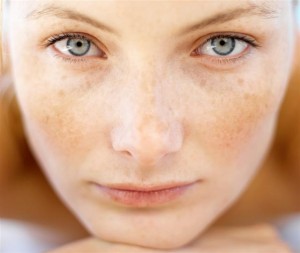Q&A With Dr. Anita Saluja: Skin Health
By Space Coast Medicine // October 9, 2013
WATCH FOR EARLY CHANGES SUSPICIOUS FOR CANCER
ABOVE VIDEO: Dr. Darrell Rigel, Clinical Professor of Dermatology, NYU, walks step-by-step through the process of evaluating a patient using the MelaFind® system, which is used by Dr. Saluja in her practice. See how the non-invasive, painless device can be used quickly and easily in practice to assess clinically ambiguous lesions for melanoma and learn the value of the information the system provides.
EDITOR’S NOTE: Even though the calendar shows we’ve entered Fall, in Florida, we need to continue to be aware of the effects of the sun and the damage it can cause if not evaluated early by a dermatologist. We are delighted to again welcome Dr. Anita Saluja, who practices dermatology, dermatologic surgery and cosmetic dermatology as a member of the Health First Medical Group, to share questions that she has encountered and addressed in her practice related to sun damage and alternatives to minimizing the aging process.
SPACE COAST MEDICINE: After every Florida summer, I get more brown spotting on my face. How can you clear this?

DR. SALUJA: The best medicine is prevention. You should always consider your sun precautions and apply SPF-30 all day, every day and wear a brim hat and sunglasses when you are outdoors. If you have had excessive sun exposure or are prone to spotting (hyperpigmentation), it can be cleared by a number of treatments, such as a non-invasive skin treatment package called Obagi®, which not only helps improve your skin health and beauty, but has helped reduce brown spotting. Fraxel® DUAL is another effective treatment, which uses a specific wavelength (1927nm) of light for superficial pigmentation and texture. It is basically like an eraser for the face that often times only requires one treatment after summer to remove the pigmentation.
SPACE COAST MEDICINE: I am anxious about melanoma, can you help?

DR. SALUJA: Yes, of course! Come in for a full-body skin exam if you haven’t had your moles evaluated by a professional eye. Any moles that are benign/normal looking, we can reassure you, any suspicious-looking moles, we can biopsy, and any moles that fall into the “gray zone,” we can use an FDA-approved non-invasive device called MelaFind®. MelaFind® uses visual options to look at selective moles at and below the skin surface, compares it to a database of over 10,000 melanomas and assigns a risk factor for each lesion evaluated. This is an additional tool that allows us to evaluate multiple moles without creating scars.
SPACE COAST MEDICINE: My lower lip is always dry and irritated, even though I apply lip balm – why?

DR. SALUJA: This is a condition that should be evaluated by your dermatologist because it is usually related to sun damage and is often precancerous sun damage called actinic cheilitis or actinic keratosis. Your lower lip is at higher risk for squamous cell carcinoma (SCC) because it has more direct sunlight than your upper lip. This is a condition that you should act on sooner than later.
SPACE COAST MEDICINE: What can be done to minimize scarring from skin cancer surgery?
DR. SALUJA: Anytime there is injury to the skin, whether it is from surgery, acne, or an accident, a scar will form as part of the skin’s natural healing and repair process. Scars improve over twelve months. There is a cream that we start our patients on day 3 after a procedure called SkinMedica® scar gel. We have noticed around 12 weeks post-procedure with patients who use this gel have a significant difference in the softness, fading, and appearance of the scar. Other treatment options such as intense pulse light (IPL), micro-needling, laser treatments, and skin fillers are also used to help minimize scarring. Most importantly, you need to be patient and follow all post-surgical wound care instructions.
SPACE COAST MEDICINE: What can I do to lift my skin if it’s falling?

DR. SALUJA: There are a number of non-invasive and invasive options these days for lifting certain areas of the face. Patients have options such as BOTOX®, skin fillers, as well as a new procedure called Ultherapy®, which is the only FDA-approved non-surgical, non-invasive procedure that uses ultrasound to lift the skin. To discuss each of these options and to find out which is best for you, you should have a consultation with your dermatology care team.
SPACE COAST MEDICINE: Is it too early to start BOTOX®?
DR. SALUJA: No, once you are in your 20s, BOTOX® is a great tool for prevention, especially since most of us are genetically prone to facial wrinkles. BOTOX® has great success rates for ages 20 and above, but early prevention is key for less maintenance, less quantity of BOTOX®, and the results tend to be better and more natural looking.
If you have a skin-related question you would like answered by Dr. Saluja, please contact her at 321.757.5141.

Dr. Anita Saluja is a graduate of The University of Michigan School of Medicine where she was a member of the prestigious Alpha Omega Alpha Medical Honor Society. Dr. Saluja completed her residency in dermatology specialty training at Emory University in Atlanta, GA, and is board-certified in dermatology by the American Board of Dermatology. She has practiced dermatology, dermatologic surgery and cosmetic dermatology with MIMA (now Health First Medical Group) in the Viera office since 2001. Her areas of interest include sun damaged skin, skin cancer, and cosmetic dermatology. Dr. Saluja is a working mother of two and, additionally, is very active in Brevard community organizations and projects. Dr. Saluja can be contacted at 321-757-5141 or CLICK HERE.












